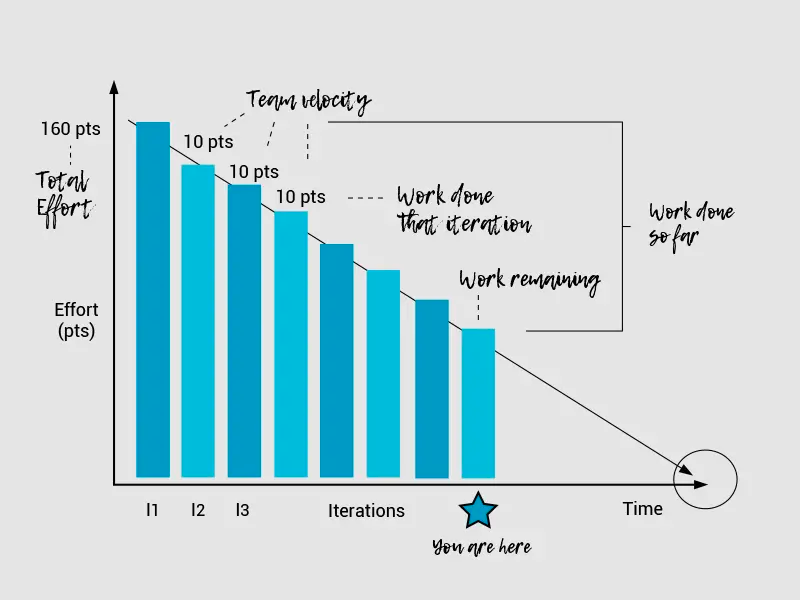Sometimes, projects can get overwhelming — especially if you’ve got lots on your plate already, and limited time to spend getting organized. This is where the use of visual organizers can be extremely helpful.
Burndown charts are a graphical representation of the work remaining for completion on a project over time. At a glance, you can see the work in progress and the estimated remaining work, which is incredibly useful when you’re on the go.
In this article, we will explore the value of burndown charts and tips on using them to their maximum effectiveness. You’ll learn how to use these charts to watch your team’s progress on critical projects and use their data to improve the overall project trajectory.
Let’s dive in!
Why Use Burndown Charts?
In any business, projects can get complicated very quickly. Burndown charts are a valuable tool for tracking the progress of a project in these instances. They can help identify when the project is behind schedule, and highlight the areas where the most work needs attention.
Tracking progress and identifying problems
One of the strengths of burndown charts is that they effectively and accurately track the progress of your project over time. As your project moves closer to the end, the burndown chart will show a decreasing slope, indicating that you are on track to finish on time.
Alternatively, they can help you identify potential problems early on in the project. For example, if the slope starts to increase near the end of the project, it may indicate that you are running out of time and need to speed up the process.

Easy analytics analysis
Visual tools like burndown charts are highly effective for tracking and monitoring progress. These charts help track any data, whether sales, customer satisfaction, or project progress. They are especially useful in agile software development, and are used to track the progress of software development iterations.
Simple to create and read
Projects require planning tools that are simple to create and easy to understand, which is why burndown charts are so useful. There are no masses of data to read through or numbers to crunch.
Instead, burndown charts consist of a simple horizontal line representing the total amount of work needed, then a series of vertical lines representing the amount of work completed. As more work is completed, the vertical lines move down the chart, and at the end of the iteration, the line should reach the bottom.
Different Types of Burndown Charts
To better understand how burndown charts reflect a project’s progress, it is vital that you first understand the different types and their purposes.
There are two main types of burndown charts:
- The cumulative burndown chart shows how much work has been completed over time.
- The slope burndown chart shows how the work completed over time is changing.
The cumulative burndown chart is used to track how much work has been completed. This type of burndown chart finds use at the beginning or end of a project to understand how much work remains for completion.
The slope burndown chart, on the other hand, is used to track how the work completed over time changes. This type of burndown chart is generally used to identify trends in the amount of work completed over time.
How to Set Up a Burndown Chart
When starting a burndown chart, you can use either a bar graph or another graph to track the data. The x-axis should represent time, and the y-axis should represent the amount of remaining work.
The first step is to mark the initial point on the graph. This is typically the amount of work currently assigned to the team.
You will need to track the amount of work completed regularly. This can be done by marking the amount of work completed each day in your burndown chart.
If you are using a bar graph, you will need to create a separate bar for each day. The bar will represent the amount of work completed on that day. As work is completed, the line on the graph should move downwards.

Make the Most of Your Burndown Chart
There are many ways burn down charts can help with your project. Here are a few tips for using them:
- Create a baseline chart at the beginning of the project.
- Update the chart as work gets completed.
- Use the chart to identify when the project is behind schedule and the areas needing the most attention.
- Compare the current chart to the baseline chart to track progress.
As a tool for tracking a project’s progress, your burndown chart is a graphical representation of the work that remains to be done on a project and the work completion rate. The y-axis of the burndown chart typically represents the number of tasks or work items remaining, while the x-axis represents time.
Typically, your burndown chart will have three lines:
- The first line shows the total number of tasks or work items at the beginning of the project.
- The second line shows the number of work items completed over time.
- The third line shows the rate of work being achieved over time.
You can use a burndown chart to answer essential questions about your project, including:
- How much work remains?
- How quickly is the work being completed?
- What is the trend over time?
- Is the project on track?
Using Burndown Charts to Track Progress
One of the most helpful features of burndown charts is that they aid you in tracking your progress.
Burndown charts can track any work, including software development projects. You could use a burndown chart to track the progress of a house renovation project or the progress of a weight loss goal.
There are a few key benefits of using burndown charts to track progress:
- They help you to visualize your progress over time.
- They help you to identify any potential bottlenecks in your project.
- They help you to track your progress against your goals.
- They help you to determine when you need to adjust your plans.
- They help you to determine when you need to take corrective action.
One of the convenient uses of burndown charts is using them to identify would-be roadblocks in your project. If your burndown chart shows one of these potential issues, the sooner you address it, the less likely it will become a problem.

Potential Issues With Burndown Charts
Something to keep in mind about burndown charts is that they can be misleading if not used correctly.
For example, if the team only completes a small amount of work at the end of the sprint, the burndown chart will show that the team is behind schedule. However, this may not be the case if the team only completed a small amount of work because they were close to completing the sprint’s work.
This is an example of one of the few issues with burndown charts: that they treat each task with equal importance. Because of this, you might see your project’s progress misrepresented by the chart. In this case, the burndown chart would not accurately represent the team’s progress.
Breaking Down Task Importance In Burndown Charts
Progress in burndown charts is measured in relation to the completion of tasks, and in order to accurately track your project’s progress, you need to first understand the value of each task.
Importance is measured in terms of the task’s relationship to other tasks and project goals. Some tasks are more important because they are essential to the completion of the project, while others are less important because they can be completed without affecting the project’s outcome.
When you break down task importance in burndown charts, you look at how each task relates to other tasks. You are also looking at how much time each task takes to complete.
You can determine task importance by several factors, including:
- The time it will take to complete the task
- The impact the task will have on the project if not completed on time
- The dependencies the task has on other tasks
By examining how important each task is to other project components, your burndown chart will be able to tell you whether you are making progress on your project or not.

Conclusion
Burndown charts are an excellent, effective way of tracking a project’s progress. You can use them to track the progress of tasks, individual work items, or entire projects. These charts are especially helpful when you need to track and manage the progress of a project over time.
Tools like time trackers, project organization platforms, and burndown charts make managing your projects a breeze. By using a burndown chart to analyze the progress of your project, you can quickly see which tasks are the most important and need your attention.
Your burndown charts will become an essential part of your project management methods. These charts will help you to better understand the progress of your project, identify potential issues, and determine the necessary actions to take in order to keep your project on track. In other words, burndown charts will become your projects’ new best friend!
